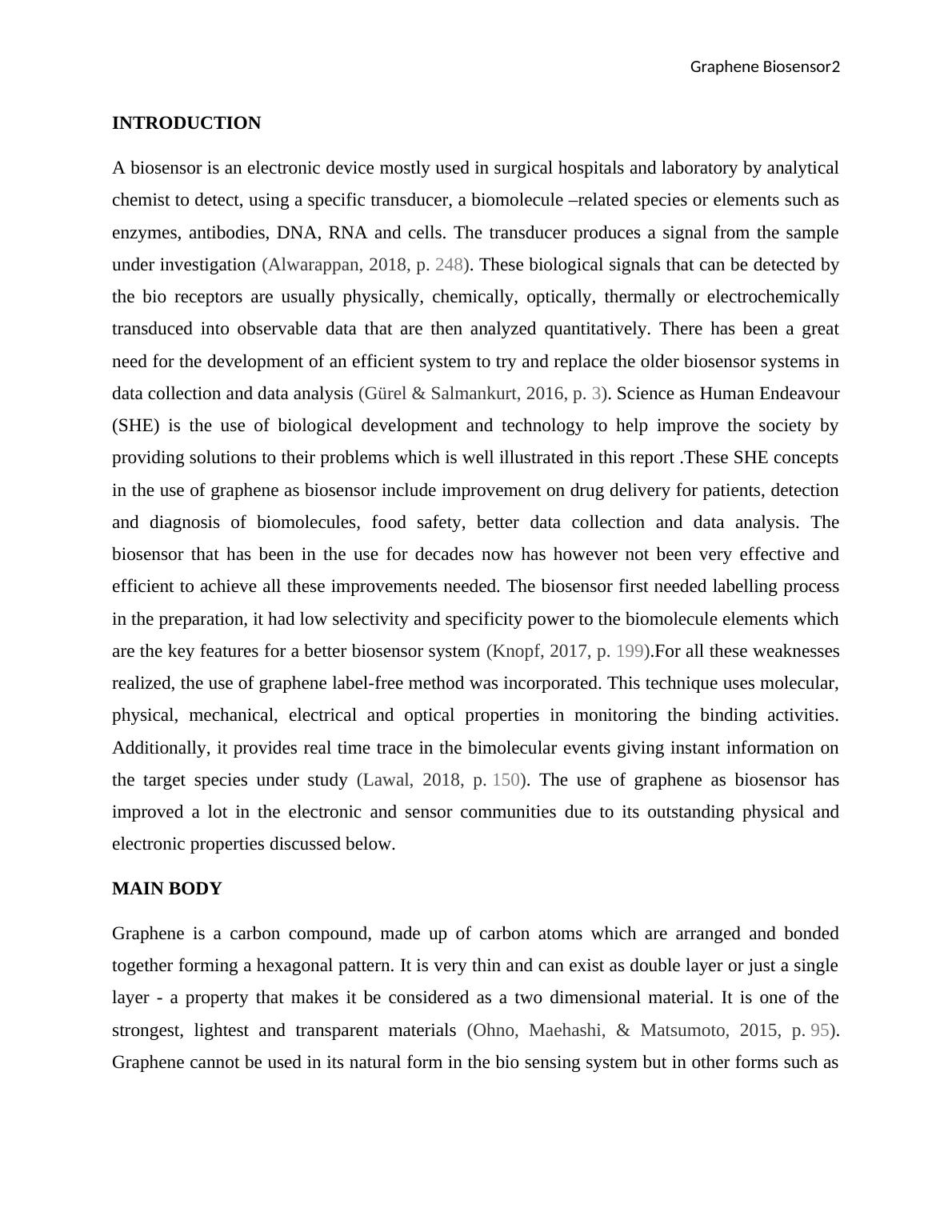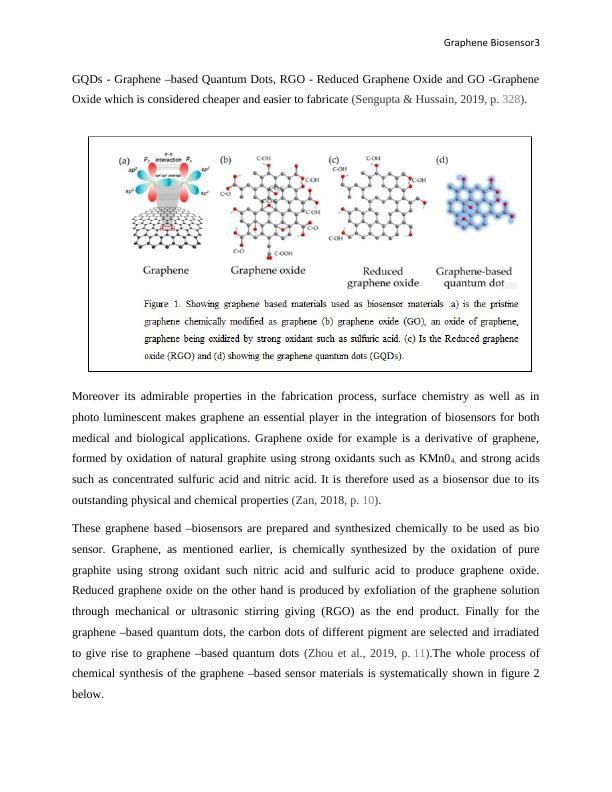Use of Graphene as a Biosensor
Added on 2023-01-16
7 Pages1609 Words96 Views
Graphene Biosensor1
USE OF GRAPHENE AS A BIOSENSOR
By (Name)
Course
Tutor
Learning Institution
Date
USE OF GRAPHENE AS A BIOSENSOR
By (Name)
Course
Tutor
Learning Institution
Date

Graphene Biosensor2
INTRODUCTION
A biosensor is an electronic device mostly used in surgical hospitals and laboratory by analytical
chemist to detect, using a specific transducer, a biomolecule –related species or elements such as
enzymes, antibodies, DNA, RNA and cells. The transducer produces a signal from the sample
under investigation (Alwarappan, 2018, p. 248). These biological signals that can be detected by
the bio receptors are usually physically, chemically, optically, thermally or electrochemically
transduced into observable data that are then analyzed quantitatively. There has been a great
need for the development of an efficient system to try and replace the older biosensor systems in
data collection and data analysis (Gürel & Salmankurt, 2016, p. 3). Science as Human Endeavour
(SHE) is the use of biological development and technology to help improve the society by
providing solutions to their problems which is well illustrated in this report .These SHE concepts
in the use of graphene as biosensor include improvement on drug delivery for patients, detection
and diagnosis of biomolecules, food safety, better data collection and data analysis. The
biosensor that has been in the use for decades now has however not been very effective and
efficient to achieve all these improvements needed. The biosensor first needed labelling process
in the preparation, it had low selectivity and specificity power to the biomolecule elements which
are the key features for a better biosensor system (Knopf, 2017, p. 199).For all these weaknesses
realized, the use of graphene label-free method was incorporated. This technique uses molecular,
physical, mechanical, electrical and optical properties in monitoring the binding activities.
Additionally, it provides real time trace in the bimolecular events giving instant information on
the target species under study (Lawal, 2018, p. 150). The use of graphene as biosensor has
improved a lot in the electronic and sensor communities due to its outstanding physical and
electronic properties discussed below.
MAIN BODY
Graphene is a carbon compound, made up of carbon atoms which are arranged and bonded
together forming a hexagonal pattern. It is very thin and can exist as double layer or just a single
layer - a property that makes it be considered as a two dimensional material. It is one of the
strongest, lightest and transparent materials (Ohno, Maehashi, & Matsumoto, 2015, p. 95).
Graphene cannot be used in its natural form in the bio sensing system but in other forms such as
INTRODUCTION
A biosensor is an electronic device mostly used in surgical hospitals and laboratory by analytical
chemist to detect, using a specific transducer, a biomolecule –related species or elements such as
enzymes, antibodies, DNA, RNA and cells. The transducer produces a signal from the sample
under investigation (Alwarappan, 2018, p. 248). These biological signals that can be detected by
the bio receptors are usually physically, chemically, optically, thermally or electrochemically
transduced into observable data that are then analyzed quantitatively. There has been a great
need for the development of an efficient system to try and replace the older biosensor systems in
data collection and data analysis (Gürel & Salmankurt, 2016, p. 3). Science as Human Endeavour
(SHE) is the use of biological development and technology to help improve the society by
providing solutions to their problems which is well illustrated in this report .These SHE concepts
in the use of graphene as biosensor include improvement on drug delivery for patients, detection
and diagnosis of biomolecules, food safety, better data collection and data analysis. The
biosensor that has been in the use for decades now has however not been very effective and
efficient to achieve all these improvements needed. The biosensor first needed labelling process
in the preparation, it had low selectivity and specificity power to the biomolecule elements which
are the key features for a better biosensor system (Knopf, 2017, p. 199).For all these weaknesses
realized, the use of graphene label-free method was incorporated. This technique uses molecular,
physical, mechanical, electrical and optical properties in monitoring the binding activities.
Additionally, it provides real time trace in the bimolecular events giving instant information on
the target species under study (Lawal, 2018, p. 150). The use of graphene as biosensor has
improved a lot in the electronic and sensor communities due to its outstanding physical and
electronic properties discussed below.
MAIN BODY
Graphene is a carbon compound, made up of carbon atoms which are arranged and bonded
together forming a hexagonal pattern. It is very thin and can exist as double layer or just a single
layer - a property that makes it be considered as a two dimensional material. It is one of the
strongest, lightest and transparent materials (Ohno, Maehashi, & Matsumoto, 2015, p. 95).
Graphene cannot be used in its natural form in the bio sensing system but in other forms such as

Graphene Biosensor3
GQDs - Graphene –based Quantum Dots, RGO - Reduced Graphene Oxide and GO -Graphene
Oxide which is considered cheaper and easier to fabricate (Sengupta & Hussain, 2019, p. 328).
Moreover its admirable properties in the fabrication process, surface chemistry as well as in
photo luminescent makes graphene an essential player in the integration of biosensors for both
medical and biological applications. Graphene oxide for example is a derivative of graphene,
formed by oxidation of natural graphite using strong oxidants such as KMn04, and strong acids
such as concentrated sulfuric acid and nitric acid. It is therefore used as a biosensor due to its
outstanding physical and chemical properties (Zan, 2018, p. 10).
These graphene based –biosensors are prepared and synthesized chemically to be used as bio
sensor. Graphene, as mentioned earlier, is chemically synthesized by the oxidation of pure
graphite using strong oxidant such nitric acid and sulfuric acid to produce graphene oxide.
Reduced graphene oxide on the other hand is produced by exfoliation of the graphene solution
through mechanical or ultrasonic stirring giving (RGO) as the end product. Finally for the
graphene –based quantum dots, the carbon dots of different pigment are selected and irradiated
to give rise to graphene –based quantum dots (Zhou et al., 2019, p. 11).The whole process of
chemical synthesis of the graphene –based sensor materials is systematically shown in figure 2
below.
GQDs - Graphene –based Quantum Dots, RGO - Reduced Graphene Oxide and GO -Graphene
Oxide which is considered cheaper and easier to fabricate (Sengupta & Hussain, 2019, p. 328).
Moreover its admirable properties in the fabrication process, surface chemistry as well as in
photo luminescent makes graphene an essential player in the integration of biosensors for both
medical and biological applications. Graphene oxide for example is a derivative of graphene,
formed by oxidation of natural graphite using strong oxidants such as KMn04, and strong acids
such as concentrated sulfuric acid and nitric acid. It is therefore used as a biosensor due to its
outstanding physical and chemical properties (Zan, 2018, p. 10).
These graphene based –biosensors are prepared and synthesized chemically to be used as bio
sensor. Graphene, as mentioned earlier, is chemically synthesized by the oxidation of pure
graphite using strong oxidant such nitric acid and sulfuric acid to produce graphene oxide.
Reduced graphene oxide on the other hand is produced by exfoliation of the graphene solution
through mechanical or ultrasonic stirring giving (RGO) as the end product. Finally for the
graphene –based quantum dots, the carbon dots of different pigment are selected and irradiated
to give rise to graphene –based quantum dots (Zhou et al., 2019, p. 11).The whole process of
chemical synthesis of the graphene –based sensor materials is systematically shown in figure 2
below.

End of preview
Want to access all the pages? Upload your documents or become a member.
Related Documents
Components of a Biosensorlg...
|4
|678
|1
Application of Mesoporous Silica Nanoparticleslg...
|6
|1263
|33
Vibrational Properties of Defected Graphene Nanoribbonlg...
|20
|4164
|63
